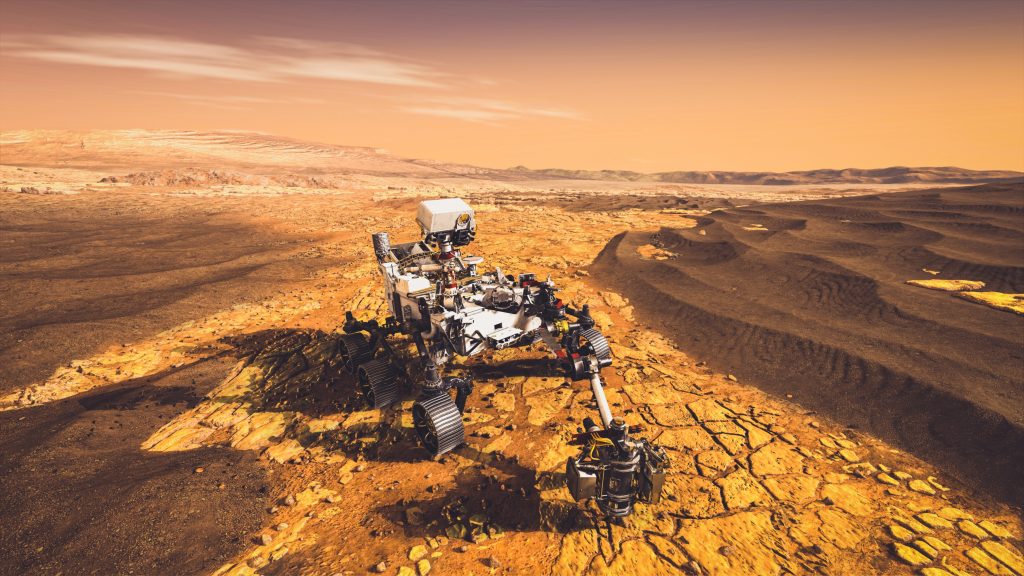Making history on Mars
The Perseverance rover landed on Mars on February 18, 2021. So you might be wondering, how and why was this sophisticated “mobile astrobiologist” named Perseverance? Well, last year in March, a seventh grader in Virginia submitted a winning entry to name the 2021 Mars Rover. Alexander Mather chose “Perseverance.” The rover was launched last year on July 30, 2020 and traveled 300 million miles in seven months, at speeds reaching 12,100 mph.
Engineers and scientists had to plan for every step of the landing. They programmed the rover to land itself. The parachute slowed the rover down to 160 mph. 70 feet above the ground, the Sky Crane, powered with rockets, deployed and slowed down the rover before lowering to the surface using cables. The rover sent back a photo as soon as it landed, but since it’s been about a week, it has had time to send back video footage of its landing, photos, and its first audio recording of the Martian breeze.
Data will be transferred back to earth at slow “old school” dial-up speeds. An orbiter also helps transmit data to inform scientists on Earth. They are using new and updated equipment to learn new things about the Mars atmosphere. They are better able to compare the Mars atmosphere to Earth’s and draw further conclusions about life on Mars.
The rover is encased inside a protective shell, which shielded the rover as it enters the Mars atmosphere. This “aeroshell” has built-in sensors that collected data about the atmosphere. Data on wind, energy, and gases that come into contact with the rover will be collected, measured, and studied. Another shell, the “heat shield,” also submits data back to NASA, who will review how well it protected the rover while it was landing.
Jezero Crater – The landing site
Jezero Crater, which is viewable from this online NASA map, was the best option to land since it featured several geological places of interest to NASA scientists. Researchers believe this area once had a lake 3.5 billion years ago. The rover will use its drill and collection system to take geological samples that will be stored for a future return mission to Earth. Scientists would be able to study the samples for evidence of past life on Mars. Even if there is no evidence of life, it will still be a historic discovery to see what else Mars is made of, since no one has studied Martian soil before.
Perseverance will test whether or not oxygen can be produced from the Martian atmosphere. If it can, this may help make it possible to send people to Mars on a future mission.
NASA JPL – Notable Native Engineer
We know something about one of the lead mechanical engineers who contributed to four Mars missions: the Mars Science Laboratory Rover mission, the Mars InSight Lander mission, the Curiosity Rover mission, and the 2020 Perseverance Rover mission.
His name is Aaron Yazzie, and he is from the Navajo Nation. Together with his mechanical engineering team, he helped develop the pressure inlets for the Insight lander. He has previous experience studying Jupiter, Earth, and Mars. More recently, he developed the drill bits for both the Curiosity and the Perseverance rovers. The Perseverance features a “suite of interchangeable bits: coring bits, regolith bit and an abrader,” which are located on the robotic arm. (Regolith means “rocky material” and the abrader helps scrape up the soil and rocky materials.)
The drill bits Yazzie and his team designed for Perseverance rover can drill one-inch holes into rocks. The robotic arm with its drill is 7 feet long and is fitted with cameras and sensors for precise drilling and sample collection. The rover is scheduled to begin taking soil samples this summer.
Yazzie enjoys doing STEM outreach to students from the Navajo Nation and beyond. He received the 2019 Bruce Murray Award for “excellence in education and public engagement” for his efforts to promote inclusion and excitement for STEM in indigenous communities.
When will the samples return?
Engineers are planning for a “fetch rover” that will find the samples and then launch from Mars back to Earth, hopefully by 2031. Until then we will continue to explore Mars through the exciting new lens of Perseverance, which has presented itself as a beacon of hope and inspiration amid the Covid-19 pandemic.
Resources for Teachers
- Mars Exploration Program – This is the main website for NASA Mars Exploration.
- Mars Weather – What’s the weather on Mars? See data sets for the seasons.
- Meet the Mars Rovers – Cartoon rovers engage kids with some Martian exploration history and facts.
- What Tools Would You Take to Mars? – This online science lesson includes a KWL chart for teachers.
- Explore Mars: A Rover Game – You get to drive a virtual Mars rover in this in-browser Unity game using commands to steer it! Features a cerebral game soundtrack and the voice talents of a NASA Systems Engineer, Charlene Valerio.
- The Fun Zone – Time for a lesson break? Find coloring sheets and video games here.
- Aaron Yazzie Poster – From AISES, “I am Dine’, I am STEM.”
- NOVA Episode Looking for Life on Mars – 53 minutes about the Mars 2020 Mission.


